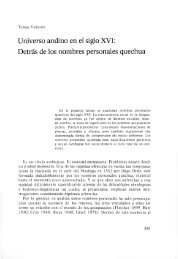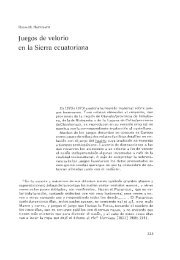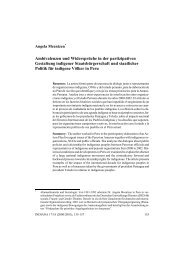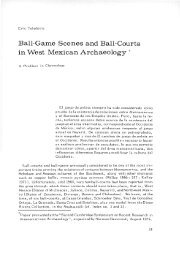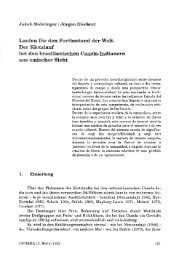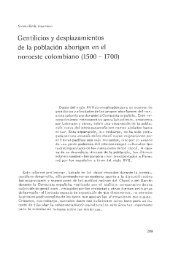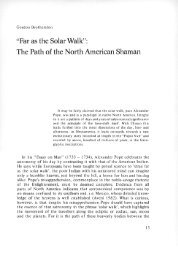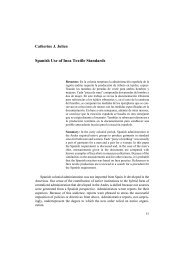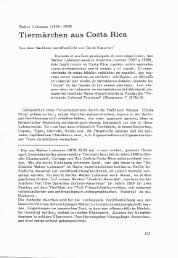Time and Script in Ancient Mesoamerica
Time and Script in Ancient Mesoamerica
Time and Script in Ancient Mesoamerica
You also want an ePaper? Increase the reach of your titles
YUMPU automatically turns print PDFs into web optimized ePapers that Google loves.
ithmetical notation, the supposed Maya 'zero' sign is better said simply to<br />
be the 'absence' of one or the other (Ibarra Grasso 1970). But on the other<br />
h<strong>and</strong>, just because the year ceased calendrically to be the l<strong>in</strong>k with astronomical<br />
time that it was elsewhere, could its length be better related to other<br />
cycles (lunar, planetary) <strong>in</strong> numbers of identical days. Indeed, all claims<br />
that the details of such cycles are recorded except <strong>in</strong> the Long Count system<br />
are disputable, though they were doubtless generally known about. At best<br />
the so-called Aztec 'Sun Stone', <strong>and</strong> similar records, may relate whole solar<br />
with v/hole Venus periods. Seler was probably wrong to discover the<br />
stations of a Venus period expressed as days <strong>in</strong> the non-Long Count Borgia<br />
Codex (p.53; Nowotny 1961: 37 <strong>and</strong> 237); <strong>and</strong> if our argument so far is correct,<br />
he would have had to have been, <strong>in</strong> any case.<br />
Much emphasis has been placed on Maya <strong>in</strong>terest <strong>in</strong> co<strong>in</strong>cidence <strong>in</strong> time,<br />
on how they used the Long Count to register 'resonance' between cycles of<br />
celestial bodies like sun, moon <strong>and</strong> Venus, these often echo<strong>in</strong>g, no doubt because<br />
they are true, similar discoveries <strong>in</strong> the Old World, like the Metonic<br />
cycle <strong>and</strong> the Chang of the Ch<strong>in</strong>ese. In the classic <strong>in</strong>scriptions <strong>and</strong> the Dresden<br />
Codex, cycles of this k<strong>in</strong>d are correlated with each other <strong>and</strong> with the<br />
Sacred Round, now considered less sacred than an <strong>in</strong>strument of calculation.<br />
At Copan 149 moons are registered as 4,400 solar days ; <strong>in</strong> effect the lunation<br />
was calculated to with<strong>in</strong> .00039 of a day (Coe 1966: 161). Besides giv<strong>in</strong>g detailed<br />
<strong>in</strong>formation on the synodic cycle of Venus, the Dresden Codex equates<br />
405 lunations with 46 x 260 or 11,960 days, <strong>and</strong> effectively locates eclipse<br />
periods with<strong>in</strong> 18 days either side of the node, <strong>and</strong> possibly even allowed for<br />
the recession of the node (Coe 1966: l6l; Andrews 1967; Thompson 1972).<br />
This concern with resonance <strong>in</strong> time has occasionally led to the suspicion<br />
that the ma<strong>in</strong> content of the classic <strong>in</strong>scriptions, still largelyundeciphered,<br />
is astronomical, <strong>and</strong> that the Maya underst<strong>and</strong><strong>in</strong>g of time was cyclic rather<br />
than progressive or l<strong>in</strong>ear. However, from the start it has been clear that<br />
the priests at the various classic sites worked witha base date, from which<br />
contemporary <strong>and</strong> other dates were counted forward <strong>in</strong> days. This date, 4<br />
ahau 8 cumhu, a day <strong>in</strong> a year c. 3113 B.C., marked the beg<strong>in</strong>n<strong>in</strong>g of the<br />
present era, of 13 baktuns (1,872,000 days or about 5,000 years), like others<br />
notionally prior to it. Recent work on the <strong>in</strong>scriptions, saliently by Proskouriakoff,<br />
has shown that at several sites the pattern<strong>in</strong>g of glyphs <strong>in</strong> their<br />
irregularity hardly always suggest astronomical cycles, <strong>and</strong> would much<br />
sooner also record local historical events. This discovery can only <strong>in</strong>crease<br />
our amazement at Maya record<strong>in</strong>g of time, for as we noted above, <strong>in</strong> the Old<br />
World history <strong>in</strong> this sense was not <strong>in</strong>tegrated fully <strong>in</strong>to astronomical time<br />
reckon<strong>in</strong>g until comparatively late. The Maya rulers may perhaps be said to<br />
be the first on the planet to have been honoured with so cosmic a record of<br />
their existence.<br />
The form of the <strong>in</strong>scriptions, on ceremonial stelae <strong>and</strong> elsewhere at the<br />
classic sites, has been excellently described by those who have deciphered<br />
them. But it is worth recall<strong>in</strong>g here (fig.8) because of the <strong>in</strong>timacy, <strong>in</strong> Me-<br />
20





